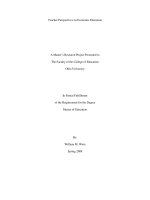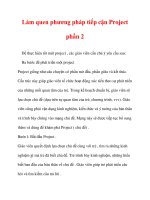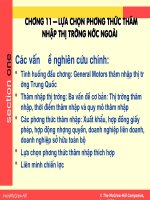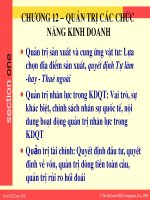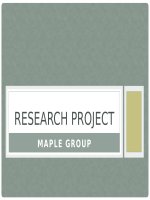Research project Assignment 2 slide
Bạn đang xem bản rút gọn của tài liệu. Xem và tải ngay bản đầy đủ của tài liệu tại đây (648.06 KB, 68 trang )
Research project
Maple group
Table of contents
Chapter 1: Introduction
Chapter 2: Literature review
Chapter 3: Research methodology
Chapter 4: Research finding
Chapter 5: Conclusion and recommendation
Chapter 1: Introduction
1.1 Research Background
1.1.1 History of the company
PepsiCo, Inc. is an America multinational company headquartered in Purchase, New York, United States.
Currently, it leads in convenient snacks, foods and beverages with revenues of more than 60$ billion and over
285,000 employees from over 200 countries in over the world. PepsiCo consists of PepsiCo Americas Foods
(PAF), PepsiCo Americas Beverages (PAB) and PepsiCo International (PI). According to detail information
which is posted in PepsiCo’s website, the company experiences more than 47 years with many development
stages. Below is some main point in the history of PepsiCo:
Chapter 1: Introduction
1.1.2 Mission and Vision
Mission
•
PepsiCo’s mission is “to be the world’s premier consumer Products Company focused on convenient foods and beverages. PepsiCo try to
produce financial rewards to investors as we provide opportunities for growth and enrichment to our employees, our business partners and the
communities in which we operate. And in everything we do, we strive for honestly, fairness and integrity” (PepsiCo, n.d.)
Vision
•
It can be said that vision of PepsiCo is very precious because they understand the role of customer in business. They focus more on customers
and environment around customers. This proves that PepsiCo only interested in economic development - immediate benefit, that they ignored
the long-term benefits of environmental protection and health of customer as well. This makes increase the belief of customer with company.
Therefore, since established, the strategic vision of PepsiCo makes the company develop significantly and in a short time, it becomes market
leader of Fast-Moving Consumer Goods (FMCG) industry.
Chapter 1: Introduction
1.2 Problem Statement
•
Problem 1: The difficulties in product quality inspection in Vietnam (Quality inspection factor)
•
Problem 2: There are many gaps in Vietnam counterfeiting law (Regulation factor)
•
Problem 3: Citizens do not have high awareness in fighting against counterfeit products (Customer awareness factor)
•
Problem 4: Vietnam government and company is lack of propaganda program to help customer distinguish between original and counterfeit
products (Activity factor)
Chapter 1: Introduction
Research Objective
•
In competitive business environment, Vietnam government has many ways to protect benefits of companies and
customers. One of them is counterfeiting law.
•
To understand the advantages and the disadvantages of Vietnam’s counterfeiting law which influence on
awareness and behavior of PepsiCo’s customers
•
To find out the main reason that Vietnam government cannot prevent development of counterfeit and poor
products
•
•
To help PepsiCo have more information about regulations and new terms of the counterfeiting law of Vietnam
To understand deeply ways that counterfeit product spread into market to prevent its development
Chapter 1: Introduction
1.4 Significant of study
•
First, for company (PepsiCo), this research will help them understand more about counterfeiting situation in Viet Nam. Then, it will be much
easier for PepsiCo to find out the solutions and they can feel comfortable to cooperate with the government to prevent counterfeiting.
•
Second, for managers and employees, this research gives more knowledge about regulations of Vietnam counterfeiting law so that
managers and employees recognize the important role of counterfeiting law. From this awareness, managers and employees can give new
ideas, give the best ways to fighting against counterfeit and poor products, and improve the shortcomings in protecting their brand to remain
the development of company and PepsiCo’s leader position.
•
Third, for customers, the research help customers raise awareness in distinguish counterfeit and poor product to ensure legal benefits and
give some ways to deal with problems when buying counterfeit and poor product.
•
Fourth, for students, this research helps student know how Vietnam counterfeiting law impact on customers of specific company. Moreover,
students have more experiences to do research especially research about the Vietnam counterfeiting law and have more understanding about
the business environment in Vietnam.
•
Finally, for future researchers, by using our information and data, comparing with our strong point and weakness; they can improve their
research successfully.
Chapter 1: Introduction
1.5. Research Questions/ Hypotheses
•
1.5.1 Research Questions
The research question for this study will be:
•
•
•
•
•
•
1. What is the respondents’ profile in terms of?
1.1 Gender
1.2 Age
1.3 Occupation
1.4 Education level
1.5 Civil status
2. What is the significant relationship between the respondents’ profile and their awareness
of PepsiCo’s customers about Vietnam counterfeiting law?
3. What are the problems in applying counterfeiting law in Vietnam?
•
•
•
•
•
3.1 Quality inspection
3.2 Regulation
3.3 Customer awareness
3.4 Activity
3.4 Living standard
4. What is the significant relationship between problems in applying Vietnam counterfeiting
law and behavior of customers of PepsiCo?
Chapter 1: Introduction
1.5.2 Hypotheses
1.
2.
3.
Is there a significant relationship between gender of respondents and their awareness PepsiCo’s customers about Vietnam counterfeiting law?
Is there a significant relationship between age of respondents and their awareness of PepsiCo’s customers about Vietnam counterfeiting law?
Is there a significant relationship between occupation of respondents and their awareness of PepsiCo’s customers about Vietnam counterfeiting
law?
4.
Is there a significant relationship between education level of respondents and their awareness of PepsiCo’s customers about Vietnam
counterfeiting law?
5.
Is there a significant relationship between civil status of respondents and their awareness of PepsiCo’s customers about Vietnam counterfeiting
law?
6.
7.
8.
9.
10.
Is there a significant relationship between quality inspection factor and behavior of PepsiCo’s customers?
Is there a significant relationship between regulation factor and behavior of PepsiCo’s customers?
Is there a significant relationship between customer awareness factor and behavior of PepsiCo’s customers?
Is there a significant relationship between activity factor and behavior of PepsiCo’s customers?
Is there a significant relationship between living standard factor and behavior of PepsiCo’s customers?
Chapter 1: Introduction
1.6 Action Plan and Target Date
Activities
Due dates
Members
1
Creating a group (Maple Group)
Lynn (leader), Snow,
01/03/2013
Together reading the scenario for understanding
2
3
Jess, Key
Reading scenario and understanding deeply tasks in assignment 1
02/03/2013
All members
Looking for a company which is within the limits of the scenario (Choose PepsiCo)
06/03/2013
All members
07- 09/03/2013
All members
10/03/2013
All members
4
At home, all members had to:
5
-
Think and choose are search title for PepsiCo
-
Find any documents from books and Internet which related to the research title
Holding 1st meeting for making 3 titles
Chapter 1: Introduction
1.6 Action Plan and Target Date
6
7
8
9
10
11
12
13
14
Present research title before class and asking lecturer for a title acceptance
11/03/2013
All members
The second submit titles and choose 1 research title for PepsiCo
14/03/2013
All members
Holding 2ndmeeting to make problem statements
16/03/2013
All members
Checking problem statements with lecturer
18/03/2013
Lynn
Preparing approval letter
19/03/2013
Snow
Meeting PepsiCo’s manager for a permission
21/03/2013
All members
22 - 24/03/2013
All members
Holding 3rd meeting for making the questionnaire
25/03/2013
All members
Asking lecturer for checking the questionnaire
28/03/2013
Jess
29 - 31/03/2013
All members
At home, each member prepared a suitable questionnaire for the next meeting
15
Doing chapter 1:
-
Leader divided works for each member with a deadline.
-
Members went home and did their own tasks.
Chapter 1: Introduction
16
- Members submitted their work to leader to complete chapter 1
17
01 - 03/04/2013
All members
04-07/04/2013
All members
08/04/2013
Key
09 - 10/04/2013
All members
11/04/2013
All members
12 - 14/04/2013
All members
15/04/2013
All members
Fixing chapter 3
16 - 17/04/2013
All members
- Conducting a completed report including introduction, conclusion, reference list, etc.
18 - 21/04/2013
All members
Doing chapter 2:
18
Dividing work and doing research about chapter 2
All members submitted their work to leader to conduct a completed chapter 2
Submit to lecturer to receive feedbacks
19
20
-
Checking together chapter 2 and fixing if there was any problems
Doing chapter 3:
Discuss the tasks for chapter 3 and divide work
21
22
23
24
Doing assigned tasks in chapter 3 at home
Asking lecturer for checking chapter 3
25
Submitting Assignment 1
22/04/2013
All members
26
Presentation and oral exam
9/05/2013
All members
11/05/2013
All members
27
th
Holding 4 meeting
- Discuss tasks of chapter 4
Chapter 1: Introduction
28
Conducting survey at 5 chosen places and collect data and summary the results
13- 24/05/2013
All members
27/05/2013
All members
28/05/2013-1/06/2013
All members
2/06/2013
All members
3/06/2013
All members
4-10/06/2013
All members
11/06/2013
All members
29
Holding 5
th
meeting
- Divide work about calculating in chapter 4 for each members
30
- All members submitted their work to leader to complete chapter 4
- Submit to lecturer to receive feedbacks
- Fixing chapter 4 if there was any problems
31
Holding 6
th
meeting to divide works chapter 5
32
Completed chapter 5 to submit draft for lecturer to receive feedbacks
33
Conducting a completed report including fixing mistakes in chapter 1, 2 and 3; updated action
plans ; introduction, conclusion, reference list, etc.
34
Submitting Assignment 2
Chapter 1: Introduction
1.7 Research limitations
•
•
Limitation of company support: In order to conduct the survey, we need the manager of PepsiCo to sign a letter approval first.
Time constraint: Collecting and analyzing of data need a long time for the good result while we only have one month to
complete the research, therefore, the paper cannot avoid some mistakes.
•
Limitation of respondents quantity: The result may be not objectiveness and accuracy because the number of respondents is
too small (100) while the number of consumers of PepsiCo products is very wide.
•
Limitation of respondents support: When conducting survey, employees of PepsiCo, many people do not agree to answer our
question because they do not understand objectives of research to support it.
•
Limitation of words: Research is about counterfeiting law and we have difficulty when want to analyze deeply in each case of
law because of the limitation of words.
•
Limitation of sources: We also have difficulty when the collecting information on the Internet and others sources because
counterfeiting law is not popular in Vietnam; the State and PepsiCo also public much information about it.
Chapter 1: Introduction
1.8 Research ethics
•
Research ethics is a set of rules, regulations, implementation which researcher need to comply; it describes the behavior and
responsibility of researcher with their research objects. The objective of research ethics is prescribe what researcher can or
cannot to do research, determine the power and responsibilities of researcher before doing research. It also protects the safety
and benefit of research objects to avoid abuse. To implement the study, we have to follow some ethical below:
•
First, we respect the dignity, value and benefit of participant; all participants in this research are volunteers, we do not force
anyone to do survey and we protect confidential communications.
•
We try to make them feel comfortable in helping us and when we complete results of survey, we present all information related
our survey honestly and objectivity.
•
•
•
Moreover, we informed fully about the purpose, methods and intended possible uses of the research to participants.
Besides, we commit that all information, data, results, methods and procedures in the research is true and reliable.
Especially, our research is about counterfeiting law, therefore we have to obey relevant laws and institutional and governmental
policies.
CHAPTER 2:LITERATER REVIEW
2.1 Introduction
2.1.1 Area
•
The key area of our research is “law”, it is very important not only for company, but also the whole society. First of all, all people in the world need the
law to ensure fairness in society. According to Oxford Dictionary, ‘law is the system of rules which a particular country or community recognizes as
regulating the actions of its members and which it may enforce by the imposition of penalties. Law has an important role for the economic, social,
political, and ethical ideas.
2.1.2 Topic
•
The topic of our research is “Vietnam’s counterfeiting law”. Counterfeiting, nowadays appear in every field and category of goods. Nguyen Manh Hung,
Vice President Standards Association and the Vietnamese consumer protection, said counterfeit goods, pirated goods from ordinary consumer goods
such as clothing, footwear, cosmetics, glasses ... to the high-value goods such as televisions, refrigerators, washing machines, air conditioners, etc.,
materials for the production such as rice seeds, fertilizers, crop protection products, building products such as cement, building materials, sanitary ware,
and even credit cards, airline tickets (Long, 2011).
CHAPTER 2:LITERATER REVIEW
2.2 Articles about problem
2.2.1 Quality inspection factor
•
Quality inspection is an activity by performing inspections; companies are able to identify problems early with the goal of eliminating the causes.
Utilized correctly, inspections save money by eliminating process problems and ensuring that the end product meets customers' requirements
and expectations (Product inspection, 2008). Quality inspection is very important in anti-counterfeit product in Vietnam market. It helps
government identify fake product and low quality products, from that, government have situation to reduce the number of counterfeit products in
market.
•
For example, according to a survey about management market forces in Thai Binh, although in charge of the district wide with 30 - 40 communes
and towns, but each team is allocated from 5 - 7 people, each manager must charge market of several communes (Mạnh). Both research above
do not mention about the solution for government to develop the effects of counterfeiting law, in our research, we give some solution to deal this
problem such as develop the ensure quality system, increase human force in management market force to cover all communes in market and
give strong financial institutions to decrease counterfeit products in market.
CHAPTER 2:LITERATER REVIEW
2.2.2 Regulation factor
•
Regulation of counterfeiting law is the regulation of government to provide information about who make quality inspection, the fee that
company must pay if they produce fake products and so on. It is very important to protect company and customer from the effect of fake
product with revenue and profit of company and benefit of customers (Anon, 2006).
•
Many research show counterfeit products are the result of lax management and many gaps in Vietnam counterfeiting law. Currently, there
are five administrative agencies functioning and competent to handle administrative violations of intellectual property including market
management agencies, specialized inspectors Science - Technology, Culture, Sports and Tourism, the economic police, the Committee of
the customs control of imported goods. Although management forces have many people, the effort of that is not strong. Because of
sporadic activity, there are lack of uniformity in quality such as quantity, functions and duties between the administrative agencies
functioning. Although product in market is tested by the agencies mentioned above but in counterfeiting, clones, poor quality on the
market is still flooded (NTH). In addition, according to Mr Nguyen - Market Management Department (Ministry of Industry and Trade), the
Standing Steering Committee 127TU said the sanctioning acts of production and trade in counterfeit goods is only handled by
administrative measures or non-criminal measures. It is small part of profit that counterfeit goods bring for seller (Hoa, 2010)
CHAPTER 2:LITERATER REVIEW
2.2.3 Customer awareness factor
•
Consumer awareness, which refers to a buyer's knowledge of a particular product or company, allows the buyer to get the most from what he
buys. Consumers know more about their choices when they have product information and benefit from knowing their rights, hearing about alerts
and warnings and finding out about safety issues (Thomas).
•
Beside quality and regulation, awareness factor is also an important reason that makes counterfeit goods suffuse in market. There are many
research, survey and article mention the level of citizen’s awareness in fighting against counterfeit products. Many customers know goods that
they buy are counterfeit goods but they still accept because the price of this product is suitable with their financial situation. This activity makes
fake goods develop in market and maybe make original goods decrease market share (NTH). Moreover, the limited of knowledge of customer
about the counterfeit goods can make them buy counterfeit goods that they do not know.
•
According to a survey of Vinastas, up to 62% of consumers buy counterfeit goods, counterfeit goods that they do not know (Dan, 2012). In a
research of Nielsen company, rate of counterfeit goods account for about 45% of retail sales in Hanoi and 35% in Ho Chi Minh City. Demand of
counterfeit goods is increasing because of economic recession. It helps people understand the routine use of counterfeit products is one of major
cause contributing to the uncontrolled rampant counterfeiting of the current market (Chống hàng giả/nhái: Cuộc chiến sống còn của các doanh
nghiệp, 2013).
CHAPTER 2:LITERATER REVIEW
2.2.4 Activity factor
•
•
Propaganda activity is the manipulation of public opinion. It is generally carried out
through media that is capable of reaching a large amount of people and effectively
persuading them for or against a cause. The exact meaning of propaganda is
constantly debated, however, and no specific definition is completely true. Some
argue that any persuasive communication is propaganda, while others hold that
propaganda specifically alters political opinions (Anon, n.d).
Many researches show that Vietnam government and company is lack of propaganda
program to help customer distinguish between original and counterfeit products. On
the afternoon of 11/3, Ho Chi Minh City Department of Industry and Trade launched
the program in response to Consumer Day World (15/3) (Phương, 2013). Accordingly,
there are many forms of communication, counseling to help consumers identify
counterfeit goods. It is the second propaganda program help customer during 30
years when counterfeiting goods appears in Viet Nam while the first hold more than
10 years ago; it shown that we need more and more propaganda. Exhibition attract a
large numbers of consumers to take are, find out.
CHAPTER 2:LITERATER REVIEW
2.2.5 Living standard factor
•
•
Living standard is the level of wealth, comfort, material goods and necessities
available to a certain socioeconomic class in a certain geographic area. The standard
of living includes factors such as income, quality and availability of employment,
class disparity, poverty rate, quality and affordability of housing, hours of work
required to purchase necessities, gross domestic product, inflation rate, number of
vacation days per year, affordable (or free) access to quality healthcare, quality and
availability of education, life expectancy, incidence of disease, cost of goods and
services, infrastructure, national economic growth, economic and political stability,
political and religious freedom, environmental quality, climate and safety. The
standard of living is closely related to quality of life (Investopedia).
In fact, we cannot prevent counterfeiting development because the majority of people
with low and middle incomes will accept and prefer cheap goods brand. While, tricks
and techniques produce increasingly sophisticated fakes, are closed from production,
transportation and circulation, extensive distribution from urban to rural, remote
areas.
CHAPTER 3:
RESEARCH METHODOLOGY
3.1 Research Design
3.1.1 Type of research
•
There are 3 types of research: Exploratory research, Descriptive research, Causal research. Our research type is Descriptive
research. Descriptive research is considered as survey research. It collects data in order to answer questions about the current status of
the subject or topic of study, and uses formal instruments to study preferences, attitudes, practices, concerns, or interests of a sample. In
order words, descriptive research involves collecting data in order to test hypotheses or to answer questions about the
opinions of people about the topic or issue (villanova.edu, n.d.)
3.1.2 Research method
•
We use Quantitative research design to conduct this research. Quantitative research designs are either descriptive (subjects usually
measured once) or experimental (subjects measured before and after a treatment) (Hopkins, 2008). A descriptive study establishes only
associations between variables. An experiment establishes causality.
CHAPTER 3:
RESEARCH METHODOLOGY
3.1.3 Research Design Technique
•
PepsiCo methods are applied by opening a small survey 100 random customers with simple multiple choice questions such as "Yes or No", "Agree,
Disagree, and Normal". Then, PepsiCo attempts to gather information have been issued to 100 customers in Vincom shopping mall center, BigC
supermarket, Indochina Plaza, National Economic University, and Banking Academy to review. The system of collecting data for research projects is
known as research methodology. The data may be collected for either theoretical or practical research for example management research may be
strategically conceptualized along with operational planning methods and change management. Some important factors in research methodology
include validity of research data, Ethics and the reliability of measures most of your work is finished by the time you finish the analysis of your data.
3.2 Research Sampling
Participants
•
PepsiCo collect data and review of information based on a survey of 100 random customers in Vincom shopping mall center, BigC supermarket,
Indochina Plaza, National Economic University, and Banking Academy.
•
•
•
•
•
20 customers in Vincom shopping mall center: 191 Ba Trieu, Hai Ba Trung, Ha Noi
20 customers in National Economic University: 207 Tran Dai Nghia, Ha Noi
20 customers in BigC supermarket: 222 Tran Duy Hung, Cau Giay, Ha Noi
20 customers in Banking Academy: 12 Chua Boc, Dong Da, Ha Noi
20 customers in Indochina Plaza: 239 XuanThuy, Cau Giay, Ha Noi
CHAPTER 3:
RESEARCH METHODOLOGY
3.3 Research instrument
Likert scale questions are listed in the following table:
Question 10
Never
Rarely
Sometimes
Often
Always
(0-2)
(2-4)
(4-6)
(6-8)
(8-10)
I do not care
Never heard it
Normal
Good
Very good
(0-2)
(2-4)
(4-6)
(6-8)
(8-10)
Strongly do not believe
Do not believe
Normal
Believe
Strongly believe (8-10)
(0-2)
(2-4)
(4-6)
(6-8)
Extremely dissatisfied
Dissatisfied
So-so
Satisfied
(0-2)
(2-4)
( 4-6)
(6-8)
Question 12
Question 13
Question 14
Extremely satisfied (8-10)
Question 15
Very low (0-2)
Low (2-4)
So-so (4-6)
High (6-8)
Very high (8-10)
Strongly disagree (0-2)
Disagree
Neutral
Agree
Strongly agree
(2-4)
(4-6)
(6-8)
(8-10)
Question 16, 18
Question 17
Table 3.1: Research Instrument
CHAPTER 3:
RESEARCH METHODOLOGY
Nominal question is listed as follows:
Question 1
Male
Female
Question 3
Student
Workers
Office staff
Business
Other jobs
Question 5
Single
Married
Divorced
Question 8, 9
Yes
No
Question 11
Don’t care
Throw away
Go back and change
Require for compensation
Report to authorities
